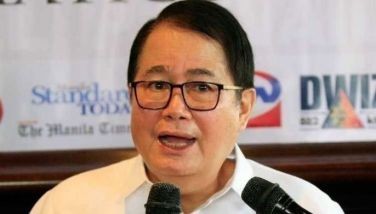Lawmakers want Bonifacio recognized as first Phl president
MANILA, Philippines - Lawmakers from the so-called Makabayan bloc in the House of Representatives pushed for the passage of a resolution recognizing Andres Bonifacio as the first president of the Philippine republic.
The lawmakers filed House Resolution 651 seeking to recognize Bonifacio as the country’s first president and urging President Aquino to institute, through the Department of Education (DepEd) and the Commission on Higher Education (CHED), measures to disseminate what they said was a historical fact in history books in elementary, high school, and tertiary education, and other related medium of information.
Reps. Luzviminda Ilagan and Emmerenciana de Jesus (Gabriela party-list), Neri Colmenares and Carlos Zarate (Bayan Muna party-list), Antonio Tinio (Act Teachers party-list), Fernando Hicap (Anakpawis party-list), and Terry Ridon (Kabataan party-list) authored the measure.
They said based on original and authentic documents of the Philippine Revolution against Spain, and as attested by historians of note such as Milagros Guerrero, Emmanuel Encarnacion and Ramon Villegas, Bonifacio founded the first national government of the Philippines and served as its president from Aug. 24, 1896 until his tragic death on May 10, 1897.
The authors said on Aug. 24, 1896, at the convention of the Kataastaasang Kapulungan or National Assembly of the Katipunan at Melchora Aquino’s barn in Barrio Banlat, now part of Caloocan, the assembly passed three major resolutions: First, they declared a nationwide armed revolution against Spain; second, they established a national government, and third, they elected officials who would lead the nation and the army.
Assembled at the convention were members of the Kataastaasang Kapulungan (Supreme Council), as well as the pangulo (heads) of the sanggunian (supra-municipal) and barangay chapter-units, the lawmakers said.
Aside from Manila, the Katipunan then had sizeable chapters in Batangas, Laguna, Cavite, Rizal, Bulacan, Pampanga, Tarlac and Nueva Ecija, and smaller chapters in Ilocos Sur, Ilocos Norte, Pangasinan and the Bicol region. Estimates of its membership vary between 30,000 and 400,000, they said.
Since the convention, the Katipunan, under Bonifacio’s leadership, ceased being a secret society and was forced to come out in the open as a revolutionary government with its own laws, bureaucratic structure and elective leadership, according to researches of John Taylor, Gregorio Zaide and Teodoro Agoncillo, the lawmakers said.
Taylor, an American military historian and custodian of the Philippine Insurgent Records, interpreted the documents that he saw: “The Katipunan came out from the cover of secret designs, threw off the cloak of any other purpose, and stood openly for the independence of the Philippines. “Bonifacio turned his (Masonic) lodges into battalions, his grandmasters into captains, and the supreme council of the Katipunan into the insurgent government of the Philippines.â€
The lawmakers said the August 1896 transformation of the Katipunan into a revolutionary government and the ensuing election of Bonifacio to the presidency were also confirmed by Pio Valenzuela in his testimony before Spanish authorities upon his surrender on Sept. 2, 1896.
The lawmakers also cited at least three letters and an appointment paper, addressed to Emilio Jacinto and written by Bonifacio on printed letterheads dated from March 8 to April 24, 1897, Bonifacio’s titles and designations were varyingly described as follows: Pangulo ng Kataastaasang Kapulungan (President of the Supreme Council), Ang Kataastaasang Pangulo (The Supreme President), Pangulo ng Haring Bayang Katagalugan (President of the Sovereign Nation of Katagalugan), Ang Pangulo ng Haring Bayan (The President of the Sovereign Nation), Maytayo ng K.K.Katipunan ng mga Anak ng Bayan (Founder of the K.K.Katipunan), Unang Naggalaw ng Panghihimagsik (Initiator of the Revolution), and Kataastaasang Panguluhan, Pamahalaang Panghihimagsik (Office of the Supreme President, Government of the Revolution). During those times the term Tagalog encompassed the whole archipelago and not just Luzon.
They said based on the book “Andres Bonifacio and the 1896 Revolution†by Guerrero, Encarnacion and Villegas published on June 16, 2003 the Kartilya (Primer) of the Katipunan defines “Tagalog,†derived from “taga-ilog†(from/of the river), as all those born in this archipelago therefore, “though Visayan, Ilocano, Pampango, etc. they are all Tagalogs.â€
In defining Tagalog as the term for all Filipinos, and “Katagalugan†as the country’s name in lieu of Filipinas, which had colonial origins, Bonifacio and the Katipunan sought to define a national identity.
- Latest
- Trending






























